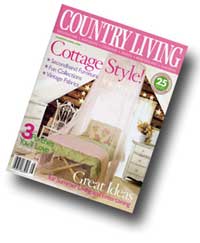National Press Coverage!!
 My camera collection was featured
in the August 2003 issue of Country Living magazine.
Unfortunately, the original article is no longer available
online, but I have reproduced the original complete text below.
As
the daughter of two devoted antiques collectors, Marti Jones was
already familiar with the joys of scouring flea markets and antiques
shops long before the camera-collecting bug bit during her senior year
of college. "I was taking a photography class and one day the professor
brought in a 19th-century daguerreotype to display," she recalls. "I
remember looking at that image and picturing how nice the wooden-case
camera that took it would look on a harvest table alongside an old
photo album."
Jones's regular antiquing trips soon involved
scooping up every camera she spotted, but over the years she narrowed
her search. "Forgive the pun, but I began to focus on a few areas that
I loved," she says. Today her collection--some 600 cameras in
all--fills an entire room in her New Hampshire home and includes styles
with colorful bodies, toy and novelty designs, and commemoratives such
as World's Fair and Boy and Girl Scouts cameras, all dating from the
1920s through the 1960s. "There is so much variety in this field that
even though I've been collecting for more than 20 years, I still see
designs that are new to me from time to time," she says.
Variety is one of the main reasons that collectors
are drawn to antique and vintage cameras. Ever since the first camera
was patented in 1839 by French physicist Louis-Jacques-Mande Daguerre
and his partner Alphonse Giroux, manufacturers have competed with one
another to introduce designs that are easier to use, lighter in weight,
and less expensive than earlier models. Nearly two centuries of
innovation have created a deep well into which today's camera
collectors may dip. Because the choices are so varied, most enthusiasts
tend to specialize in a particular area, as Marti Jones did. Some
choose a single time period-pre-1900, for example, or the Art Deco era.
Others are intrigued by the scientific aspect of photography, looking
only for cameras that were milestones in their day, such as the first
model to use roll film, or the first to incorporate a flash. Still
other collectors find a favorite maker--Kodak or Leica, for
example--and confine their search to that brand.
In today's antiques marketplace, cameras are a
frequent sight. While the most desirable models can easily reach into
the thousands, the majority of styles found on flea-market tables and
in antiques-mall booths date from the early to mid-20th century and
range in price from about $20 to $50 on the low end to several hundred
dollars apiece. A number of factors affect a camera's value. Rarity is
perhaps the most important consideration; colors or styles made only
for a limited time are prized even when the condition is less than
perfect, if the camera is no longer functioning, or if the proper film
is no longer being made. (Common designs that don't work but still have
a great look can often be purchased for far less than a usable
example.) An original box and complete accessories will also raise a
camera's value. For instance, Marti Jones's rose-colored Kodak Ensemble
(pictured in the top right corner of the previous page) has the
original box and all the accessories intact, putting its market value
at about $ 1,300 to $2,000. If one or more of the accessories were
missing, its value would drop to about $800 to $1,200. To get a sense
of current prices, historical data, and details that affect the value
of specific models, collectors in the know consult McKeown's Price
Guide to Antique and Classic Cameras (Watson-Guptill Pub.; 11th
edition, 2001; $125), edited by James and Joan McKeown.
More than two decades after her quest began, Marti
Jones's collection is still growing. Weekends often find her perusing
local flea markets and antiques shops with her 13-year-old daughter,
Bethany. "I usually set a goal for myself at the beginning of the year
of one or two styles I'd like to find," Jones says. After all these
years, she adds, her collecting philosophy has not changed: "First the
bills get paid, then I buy cameras.
RELATED ARTICLE; on-line sources
EBAY.COM The auction site is one of Marti Jones's
favorite sources for vintage cameras. For safety, always check a
seller's feedback, read item descriptions carefully, and research
before you bid. (Of the 1930s Kodak Beau Brownies pictured below, for
example, the rose model is worth three times more than the blue ones
because the color was only made for three months.)
MARTIJONES.COM See more of Marti Jones's prize
possessions--including toy and novelty designs and camera-themed
accessories--and learn how to contact the collector through her Web
site.
anatomy lesson
Condition and rarity affect a cameras value. In the
case of the 1930s Univex Model AF shown here, if the FACEPLATE is
scratch-free, the LENS clear, and the movement of the STAND and LAZY
TONGS smooth, the value would be $30 to $50. If the faceplate bore one
of several specially ordered promotional inscriptions, such as the 1936
GE Toppers Club Convention, value could rise to $250 to $350.
COPYRIGHT 2003 © Hearst Communications, Inc. All
Rights Reserved
|  |

